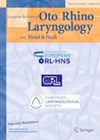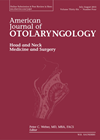
Journal Reviews
Assessing the impact of e-cigarette smoke on the vocal fold
While the use of electronic-cigarettes (e-cigs) is increasing rapidly, little is known about the effects this has on the health of vocal fold. In this translational research study, authors compared the effects of e-cig vapour and cigarette smoke on an...
How common is dysphonia and dysphagia after cardiac surgery?
Patients undergoing cardiac surgeries, such as coronary artery bypass (CABG) and valve operations, are usually informed that there may be some risk of laryngeal complications that could result in a dysphonia or dysphagia. This may be due to factors including...
Hyaluronic acid injection laryngoplasty
This systematic review discusses the use of hyaluronic acid in injection laryngoplasties. Unilateral vocal cord paralysis leads to incomplete vocal fold adduction and dysphonia. For patients not improving with voice therapy, surgical procedures include injection laryngoplasty or open laryngeal framework...
Which surgical procedure is more effective in treating OSA? Tonsillectomy or modified uvulopalatopharyngoplasty?
Obstructive sleep apnoea (OSA) is a recognised condition that is increasing in prevalence, affecting the quality of life in certain individuals. Although the first line management is non-surgical, this paper highlights the two different surgical procedures offered to patients. The...
How do objective ratings of swallowing compare with patient-reported dysphagia QOL measures in the head and neck cancer population?
Swallowing may be assessed by a comprehensive battery of tools including instrumental/objective assessments, clinician-rated measures and patient-reported measures. The authors of this paper use secondary analysis to explore concordance between videofluoroscopy and a patient-reported dysphagia quality of life (QOL) measure....
Can diet alone be used to treat laryngopharyngeal reflux?
In this crossover observational study, a low-fat, low-quick-release sugar, high-protein, alkaline, and plant-based diet was investigated as a single treatment for laryngopharyngeal reflux (LPR). Authors recruited 50 participants with demonstrated LPR on hypopharyngeal-oesophageal multichannel intraluminal impedance-pH-monitoring (HEMII-pH), off acid suppressive...
Resolving dysphagia – can we distinguish mild dysphagia from no dysphagia?
Many patients with dysphagia following neurological events can and do experience a resolution of their swallowing difficulties, sometimes without any intervention. However, it is challenging for clinicians to distinguish mild dysphagia from no dysphagia. The question of where to draw...
Coblation for laryngeal granulomas
Laryngeal granulomas remain notorious for their tendency to recur after surgical removal. Although high rates of complete remission have been reported with use of the potassium-titanyl-phosphate (KTP) laser, this equipment is expensive and not available in all units performing ENT...
What characterises dysphagia in unilateral vocal fold impairment?
The closure of the vocal folds during swallowing is known to contribute to airway protection along with epiglottic inversion and closure of the false vocal folds. It is therefore plausible to expect that unilateral vocal fold impairment without complete closure...
Effect of age-related changes in voice production and hearing on Voice Handicap Index and Geriatric Depression Scores
The ageing process affects hearing and production of voice. It is not unknown that impairment of these faculties can affect quality of life and also cause depression. The authors have presented an array of actual anatomical and functional changes that...
Dysphagia in people with HPV-related oropharyngeal cancer
Human papilloma virus (HPV) associated oropharyngeal cancers are becoming much more prevalent and, in some geographic areas, have overtaken tobacco as the leading cause of oropharyngeal cancer. HPV-associated cancers are also reported to have better prognosis in general, and research...
Predicting the nature of swallowing deficits caused by surgical resection of the tongue?
Patients treated surgically for cancer of the tongue are expected to have difficulty in eating, drinking and swallowing. The authors of this paper report on a cohort of 106 patients in their practice who had surgical resection as primary treatment....

















